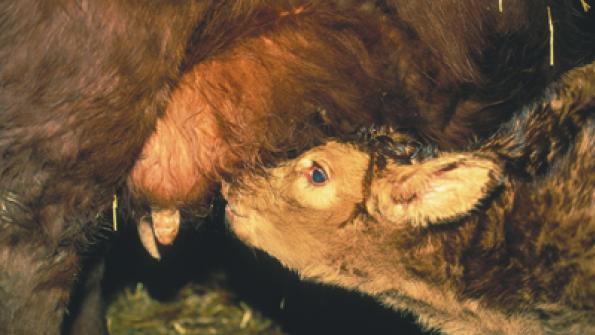Colostrum provides newborn calves with passive immunity via concentrated proteins called immunoglobulins (Ig).
December 1, 2011

Colostrum provides newborn calves with passive immunity via concentrated proteins called immunoglobulins (Ig). Newborn beef cow-calf pairs generally manage colostrum consumption quite well unattended.
But force-feeding colostrum may be necessary in situations when a calf is too weak to suckle soon after calving, has been abandoned or refused nursing by the cow, experienced a difficult birth or been exposed to severe weather. The rules of thumb are that a calf needs 2 qts. of colostrum by six hours of age and another 2 qts. by 12 hours of age; or 3 qts. in a single feeding if the calf can only be handled once. An esophageal feeder should be used.
Colostrum can be milked from any cow or heifer that lost her calf for non-disease reasons; or small amounts (up to 1 pt.) can be collected from numerous cows with an adequate supply for their calf. Care should be taken to reduce contamination of colostrum by dirty udders, unsanitary milking equipment or storage containers. It’s not recommended to collect colostrum from a neighboring farm or ranch as cattle diseases like Johne’s and salmonella can be transferred via colostrum.
Colostrum can be refrigerated for about one week after calving before quality begins to decline. Refrigerated colostrum should be stored at 33-35ºF to reduce bacterial growth which will degrade quality.
Colostrum can be stored frozen for up to a year to maintain optimum quality. Frost-free freezers aren’t recommended for long-term storage as these undergo periodic freeze-thaw cycles, which impact Ig quality.
When colostrum is needed, the main concern with thawing is to not damage the Ig proteins. This is best done in warm water (less than 120ºF). Microwaving is also effective but only on the lowest power setting while using a turntable for short periods of time.
Colostrum can be pasteurized to reduce bacterial contamination and extend storage life. Penn State University dairy researchers have shown that heat treating colostrum at 140ºF for 30 minutes reduced bacterial counts and enhanced Ig absorption.
In addition, University of British Columbia researchers reduced bacterial contamination by adding formic acid to fresh colostrum.
More calving and colostrum resources:
http://www.extension.umn.edu/beef/components/releases/3-15-06-Schott.htm
http://edis.ifas.ufl.edu/an110
http://www.jtmtg.org/2011/abstracts/0515.PDF, Abstract W18, Page 520
You May Also Like



